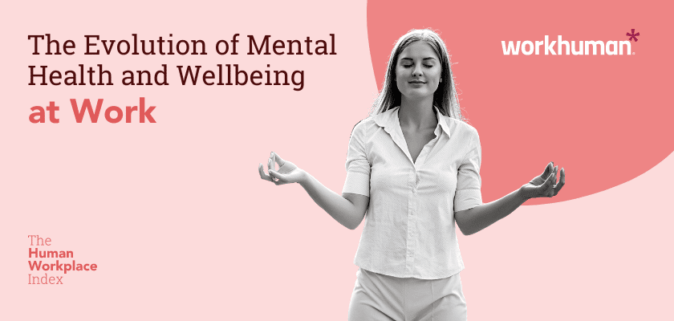Human Workplace Index: The Evolution of Mental Health and Wellbeing at Work

Within the last two years, topics once ignored in the workplace are now taking centerstage – and aren’t likely to go anywhere anytime soon.
One of those long overdue conversations is around mental health and well-being. For far too long, mental health was simply not discussed in the workplace. As COVID has continued to blur the line between work and life, however, avoiding the topic is no longer an option.
This month’s Human Workplace Index focuses on the evolution of employee wellness and mental health to determine just how supported employees are – or are not – feeling in the new world of work. Keep reading for key insights from this month’s survey.
1. On connection and belonging
Well-being is unique to each person, and employers must be acutely aware of that. For example, when asked if going back to the office would have a positive or negative impact on their well-being, 57% of respondents expected a positive impact, 12% expected a negative impact, and 31% felt neutral or were not planning to return to the office. So, while the majority of workers surveyed believe returning to work will positively impact them, that isn’t the case for everyone.
Employees who expect going back on site will have a positive impact on well-being do so for the following reasons:
- more connection (66%)
- better focus (50%)
- better work-life balance (48%)
- ability to collaborate (31%)
- less loneliness (25%)
On the other hand, workers that report being apprehensive about going back to the office feel that way for these reasons:
- having to focus more on appearance (41%)
- less time for newly established wellness routines (exercise, meditation, healthy cooking, etc.) (39%)
- working longer hours when in the office (29%)
among others!
Building better employee connection is great, but without feelings of belonging, connection alone may not be enough for employees to stick around. Lucky for employers, approximately half of workers (48%) say their sense of belonging in the workplace has increased over the last two years, thanks in part to closer bonds with co-workers (41%) and getting recognized more often for doing good work (28%).
When asked what role “belongingness” plays for them in the workplace, workers stated:
2. Mental health and wellness
The recent focus on mental health and wellness hasn’t just affected organizational policies, but also workers’ whole lives. More than half of workers surveyed (65%) report their approach to mental wellness has changed over the last two years. And employees are beginning to expect more from their employers. When asked what employees expect from their employers in terms of mental wellness, they stated:
- I expect my employer to view me as a human being - 38%
- I expect more support from my employer - 23%
- They have not changed - 21%
- I expect more human connection in the workplace - 13%
When asked how organizations should be taking care of workers’ mental wellness, the majority of workers answered, “by rewarding them for good work” (42%). Gratitude has the power to not only impact workers’ mental health, but also has a myriad of benefits for the business’s bottom line. It’s as simple as that.
And despite 51% of survey respondents reporting they somewhat or strongly agree their workplace has a positive impact on their mental health, another 43% somewhat or strongly agree they are concerned about the toll their workplace is having on their mental health. If almost half of workers surveyed are concerned about their mental wellbeing at work, there is still much work to be done.
For leaders looking to learn more about the power of hope and high-quality connections at work, check out our latest podcast episode featuring counseling psychologist, psychodramatist, author, and professor at Columbia University, Dan Tomasulo.
3. Expressing emotions at work
It’s one thing to say your organization supports employee well-being; it’s another to actually build a culture around it. This month’s survey found 63% of workers are comfortable or extremely comfortable expressing their full emotions at work. Interestingly, women are almost 2x more likely than men to feel somewhat uncomfortable or extremely uncomfortable expressing their emotions at work (21% vs 13%).
And while 47% of respondents claim their comfortability in expressing their full emotions has increased over the past two years, those who are not comfortable continue to face fear of judgment (38%) and toxic cultures (18%), among other things.
It’s worth mentioning that it’s possible not all employees want to express their full emotions at work. That may be true, but until all employees have the opportunity to choose, organizations should do more to support workers.
This is especially pressing considering 40% of workers somewhat agree or strongly agree they’re on the verge of burnout.
Feelings of burnout are unique to each individual employee and a one-size-fits-all model won’t solve everything; but increasing appreciation and support for mental well-being certainly won’t hurt. Here are six ways employers can do that right now, as provided by this month’s survey respondents.
- Provide mental health days - 53%
- More workplace flexibility - 47%
- Better mental health benefits - 40%
- Hire more people - 34%
- Offer a wellness stipend - 31%
- Create a more connected culture - 23%
Organizations looking to retain top talent should work to implement any – or all – of the suggestions above. As we continue navigating the new world of work, mental health and wellbeing should be top of mind for all employers. For workers to do their best, they must feel their best.
About the author
Sarah Bloznalis
Sarah Bloznalis is a content marketing specialist at Workhuman from Dorchester, Mass.